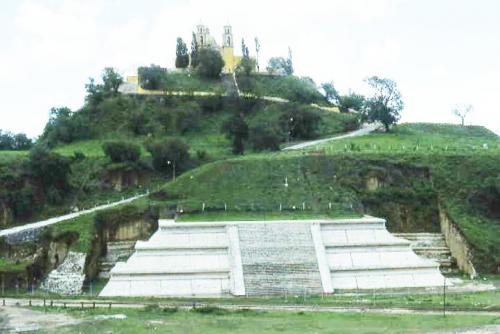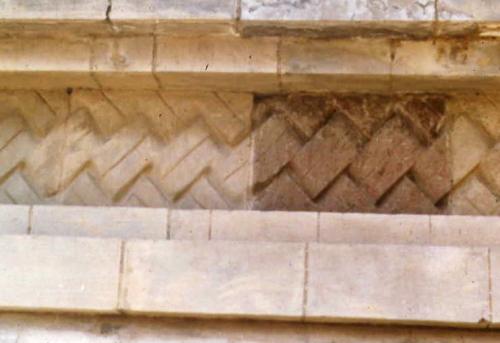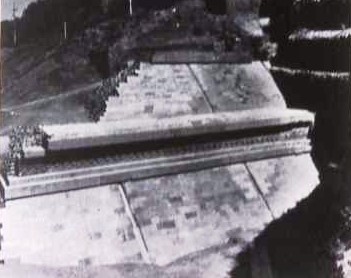West Side Stories
By Geoffrey McCafferty (2008)
The western face of the Great Pyramid is the most thoroughly restored, though the quality of the restoration is open to criticism. As part of the Proyecto Cholula of the 1960s, archaeologists exposed several late construction phases (Stages 3a, 3b, 3c, and 4), and then selected Stage 3b for consolidation (Fig. 1). Unfortunately, this was done at the expense of some of the later architecture, and the fanciful use of cement went well beyond what could reasonably be extrapolated, so the integrity of the reconstruction is problematic.

Figure 1: Reconstructed west facade of the Great Pyramid
What is known of the west facades is that Stage 3a featured a Teotihuacanoid talud-tablero form, in which the talud is an angled slope, and resting on that is a vertical tablero (Fig. 2). This architectural style is diagnostic of Teotihuacan, although its earliest examples seem to be in the Puebla region (e.g., Tlalancaleca and Tetimpa). It is notable that Stage 3a probably dates to the Epiclassic period, and thus after the fall of the Teotihuacan state, so the adoption of this style on Stage 3a probably indicates an attempt by the Cholula elite to claim the Teotihuacan legacy as a religious center.

Figure 2: Stage 3a with talud-tablero architectural style
A later modification of Stage 3 projected out to the west, and featured a more pronounced talud of well-set masonry blocks and a tablero that was decorated with sculpted blocks in the form of a mat, or petate, motif (Figs. 3 and 4). The mat motif is well known in Mesoamerica as a symbol of political authority; the Popol-Na of Copan was a council house decorated with the mat motif as an architectural element. It is unfortunate that in the artist's reconstruction of Stage 3b in the Proyecto Cholula volume (Marquina 1970) this motif was not recognized and was reproduced as simple diagonal lines.

Figure 3: Stage 3b with mat motif on tablero

Figure 4: Detail of mat motif on Stage 3b
A subsequent modification of Stage 3 resulted in dismantling the front of Stage 3b, including the staircase, for the construction of a rounded extension (Stage 3c). A photograph from the Proyecto Cholula shows what was left of Stage 3b (Fig. 5), and comparison of original stone masonry against the cement reconstruction also indicates the degree of reconstruction. Stage 3c features jagged basalt stones projecting from the steeply sloping talud, and no evidence of a tablero exists, making this a radical departure from the previous architectural program (Fig. 6). Presumably because this is a less aesthetically pleasing construction phase, it was not selected for reconstruction, and in fact it is ot recognized as a construction phase in Marquina's architectural sequence.

Figure 5: Stage 3b before reconstruction (from Marquna 1970)

Figure 6: Stages 3c (foreground) and 3b
The final stage of the Great Pyramid (Stage 4) consists of an adobe brick layer that seems to have completely covered previous architectural facades (Fig. 7). Unfortunately no finished surfaces of this stage have been recovered, so at present it simply appears as a masonry nucleus that encapsulated the earlier construction. It is unclear if Stage 4 was ever completed. Ethnohistorical evidence suggests that the Tolteca-Chichimeca took control of Cholula in the Early Cholollan phase (c. 1200 CE), and established their ceremonial center around the Pyramid of Quetzalcoatl in what is now the main square of San Pedro Cholula (about 1 km west of the Great Pyramid). It is conceivable that this transition occurred while Stage 4 was under construction. Alternatively, since building stone was such a valued commodity due to the distance to quarries, facing stonrs from Stage 4 may have been removed for the construction of subsequent buildings, such as the Pyramid of Quetzalcoatl. Future excavations could explore these suggestions.

Figure 7: Stage 4 (far left) in relation to Stages 3c and 3b
Because the front of Stage 3b was removed in antiquity, nothing remains of the original staircase. Based on the symmetry of the existing architecture, however, it can be deduced that a rough-cut stone stela would have stood in front of the stairs. This monument is roughly rectangular, and has a square hole through it (Fig. 8). Nothing is published about this monolith in the original excavation reports, and it is assumed that it is in its original position at the site. Because it is on the west side of the central staircase on the west side of the Great Pyramid, it is plausible that it may have had some relation to summer solstice observations.

Figure 8: Monolith on west side of Great Pyramid
Recent speculation about volcanic activity associated with the Popocatepetl volcano has led geomorphologist Claus Siebe to suggest that massive mudflows, or lahars, may have run off from the volcano, across the plain west of Cholula, and covered the city in a flood that would have caused the abandonment of the city during the Epiclassic period. He finds evidence of this catastrophe in an embankment to the west of the Great Pyramid (Fig. 9). Siebe and colleagues even published a date of about 800 CE from the deposit (Siebe et al. ). In fact, the deposit that the geologists identify as flood debris is plaza fill associated with the Great Plaza that separates the Great Pyramid from the Cerro Acozoc mound to the west. The fill layer has in situ adobe bricks and even plaster floors. More detailed discussion of the lahar debate can be found in Debert and McCafferty n.d.

Figure 9: Alleged lahar deposit west of Great Pyramid

